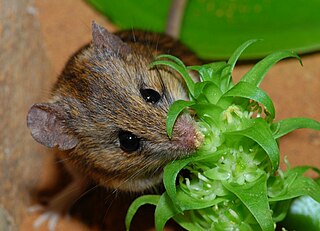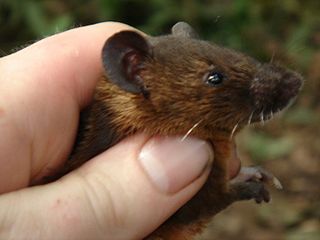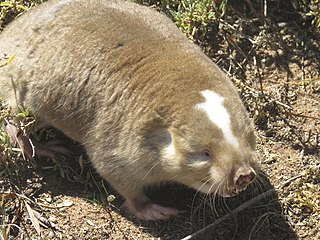
The Muroidea are a large superfamily of rodents, including mice, rats, voles, hamsters, lemmings, gerbils, and many other relatives. Although the Muroidea originated in Eurasia, they occupy a vast variety of habitats on every continent except Antarctica. Some authorities have placed all members of this group into a single family, Muridae, due to difficulties in determining how the subfamilies are related to one another. Many of the families within the Muroidea superfamily have more variations between the families than between the different clades. A possible explanation for the variations in rodents is because of the location of these rodents; these changes could have been due to radiation or the overall environment they migrated to or originated in. The following taxonomy is based on recent well-supported molecular phylogenies.

The Muridae, or murids, are the largest family of rodents and of mammals, containing approximately 1,383 species, including many species of mice, rats, and gerbils found naturally throughout Eurasia, Africa, and Australia.

The Old World rats and mice, part of the subfamily Murinae in the family Muridae, comprise at least 519 species. Members of this subfamily are called murines. In terms of species richness, this subfamily is larger than all mammal families except the Cricetidae and Muridae, and is larger than all mammal orders except the bats and the remainder of the rodents.

The bush rat or Australian bush rat is a small Australian nocturnal animal. It is an omnivore and one of the most common indigenous species of rat on the continent, found in many heathland areas of Victoria and New South Wales.

Aethomys is a genus of rodent from Africa. They are commonly referred to as rock rats, bush rats or rock mice.

Batomys is a genus of rodent endemic to the Philippines. It has six extant described species.

The Damaraland mole-rat, Damara mole rat or Damaraland blesmol, is a burrowing rodent found in southern Africa. Along with the smaller, less hairy, naked mole rat, it is a species of eusocial mammal.

Rhabdomys is a largely Southern African genus of muroid rodents slightly larger than house mice. They are known variously as striped or four-striped mice or rats. Traditionally the genus has been seen as a single species, Rhabdomys pumilio, though modern evidence on the basis of karyotype and mtDNA analysis suggests that it comprises two or more species and subspecies. Dorsally Rhabdomys species display four characteristic black longitudinal stripes on a paler background.

The red rock rat, or red veld rat, is a species of rodent in the family Muridae native to southern Africa.

The Namaqua rock rat is a species of rodent in the family Muridae. It is sometimes included in the genus Micaelamys. It is found in Angola, Botswana, Lesotho, Malawi, Mozambique, Namibia, South Africa, Eswatini, Zambia, and Zimbabwe. Its natural habitats are temperate forest, dry savanna, temperate shrubland, subtropical or tropical dry shrubland, temperate grassland, rocky areas, hot desert, temperate desert, rocky shores, arable land, rural gardens, and urban areas.
The Selinda veld rat or Silinda rock rat is a species of rodent in the family Muridae found in possibly Mozambique and Zimbabwe. Its natural habitat is subtropical or tropical dry forests.

Hapalomys is a genus of rodent in the family Muridae endemic to Southeast Asia. It is the only member of the tribe Hapalomyini. It contains the following species:

The rusty-bellied brush-furred rat is a species of rodent in the family Muridae. It is found in Angola, Benin, Cameroon, Central African Republic, Republic of the Congo, Democratic Republic of the Congo, Ivory Coast, Equatorial Guinea, Gabon, Ghana, Guinea, Kenya, Liberia, Nigeria, Sierra Leone, Tanzania, Togo, and Uganda. Its natural habitats are subtropical or tropical moist lowland forests, subtropical or tropical seasonally wet or flooded lowland grassland, arable land, and pastureland.
The thin sand rat or lesser sand rat is a species of rodent in the family Muridae. It has also been previously named the pale sand rat based on work published by Oldfield Thomas in 1925. It is found in Algeria, Libya, and Tunisia, and its natural habitats are subtropical or tropical dry shrubland and intermittent salt lakes. The thin sand rat was previously classified as a subspecies of the fat sand rat. However, morphological differences in size and coat color between the two animals, along with recent molecular evidence suggest that they are different species. The thin sand rat may be a natural reservoir for the disease leishmaniasis.

The Cape dune mole-rat is a species of solitary burrowing rodent in the family Bathyergidae. It is endemic to South Africa and named for the Cape of Good Hope.

The northeast African mole-rat is a species of rodent in the family Spalacidae and is found in Ethiopia, Somalia, and northwest Kenya. Its natural habitats are subtropical or tropical moist montane forests, dry savanna, high-altitude shrubland and grassland. It lives a solitary existence underground and produces a small litter of pups twice a year, in the two rainy seasons. Some taxonomic authorities lump this species, along with a number of others in the genus, in which case the English name East African mole-rat is used.
Guy Graham Musser was an American zoologist. His main research was in the field of the rodent subfamily Murinae, in which he has described many new species.
Louise H. Emmons is an American zoologist who studies tropical rainforest mammals, especially rodents. She has conducted fieldwork in Gabon, Sabah (Borneo), Peru, and Bolivia. Her best known work is the field guide, Neotropical Rainforest Mammals: A Field Guide, first published in 1990, with a second edition in 1997.

Arvicanthini is a tribe of muroid rodents in the subfamily Murinae. Almost all recent species in this tribe are or were found in Africa aside from one species, the Indian bush rat, which is found in South Asia and Iran. However, some fossil Golunda species from India and the genus Parapelomys are thought to have also occurred outside Africa, and one species in the fossil genus Saidomys may have also occurred in Afghanistan.














